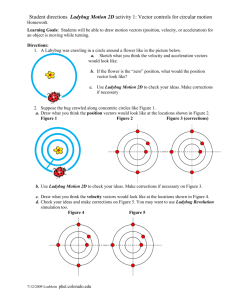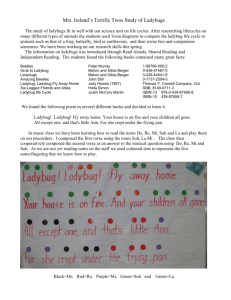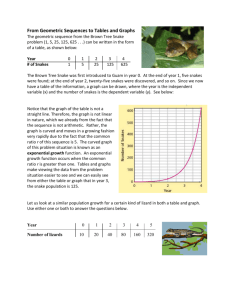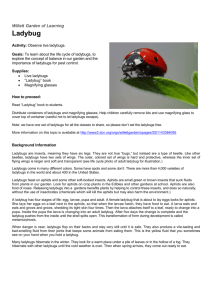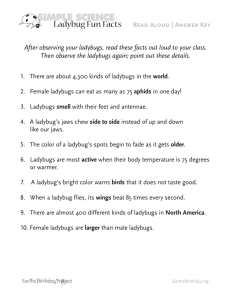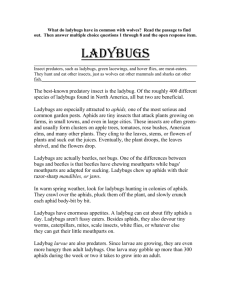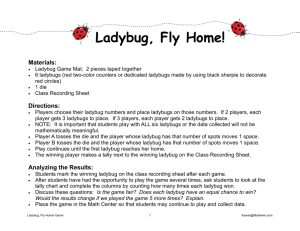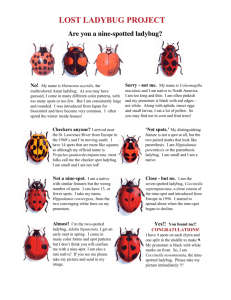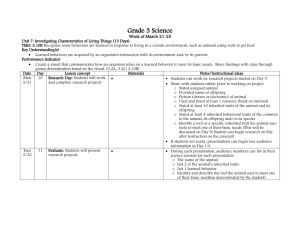There Is a Lady in the Room - The Charles A. Dana Center
advertisement
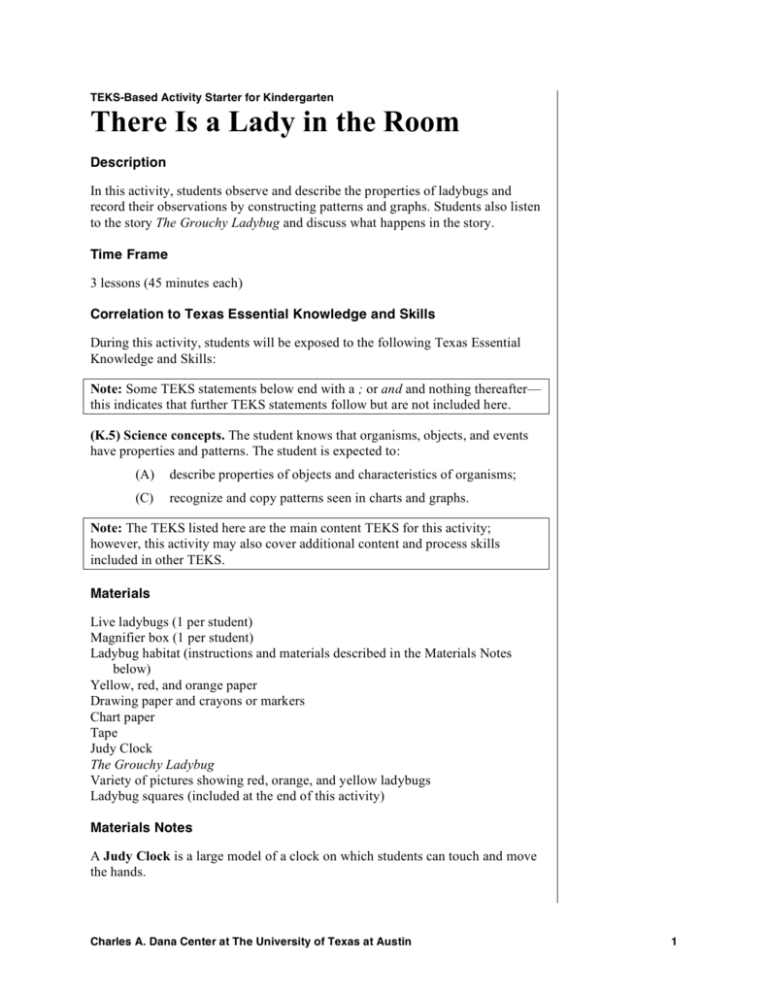
TEKS-Based Activity Starter for Kindergarten There Is a Lady in the Room Description In this activity, students observe and describe the properties of ladybugs and record their observations by constructing patterns and graphs. Students also listen to the story The Grouchy Ladybug and discuss what happens in the story. Time Frame 3 lessons (45 minutes each) Correlation to Texas Essential Knowledge and Skills During this activity, students will be exposed to the following Texas Essential Knowledge and Skills: Note: Some TEKS statements below end with a ; or and and nothing thereafter— this indicates that further TEKS statements follow but are not included here. (K.5) Science concepts. The student knows that organisms, objects, and events have properties and patterns. The student is expected to: (A) describe properties of objects and characteristics of organisms; (C) recognize and copy patterns seen in charts and graphs. Note: The TEKS listed here are the main content TEKS for this activity; however, this activity may also cover additional content and process skills included in other TEKS. Materials Live ladybugs (1 per student) Magnifier box (1 per student) Ladybug habitat (instructions and materials described in the Materials Notes below) Yellow, red, and orange paper Drawing paper and crayons or markers Chart paper Tape Judy Clock The Grouchy Ladybug Variety of pictures showing red, orange, and yellow ladybugs Ladybug squares (included at the end of this activity) Materials Notes A Judy Clock is a large model of a clock on which students can touch and move the hands. Charles A. Dana Center at The University of Texas at Austin 1 TEKS-Based Activity Starters Kindergarten—There Is a Lady in the Room A magnifier box is a transparent case with a magnifier on the lid. Small insects can be placed in the box for students to observe carefully and safely. Magnifier boxes can be purchased from educational suppliers. Ladybugs Ladybugs are actually ladybird beetles. They feed on many insects that are harmful to plants, such as aphids. When you order or purchase ladybugs, they will be in the adult beetle stage. Be sure to tell students that this adult stage is the stage that produces eggs and continues the life cycle. A ladybug life cycle is completed in about one month. You will need the following materials to create a ladybug habitat: Ladybugs Clear plastic container (at least 1 gallon capacity) Mesh or pantyhose Rubberband Leaves and stems Aphids, raisins, or apple slices Order or purchase the ladybugs for this activity. Ladybugs may be purchased from a nursery or from a biological supplier. To establish a habitat for the ladybugs, get a clear plastic container of at least a gallon in capacity. Put leaves and stems into the container. Lightly mist the leaves and stems, but do not let water collect on the bottom of the container; ladybugs can drown in very little water. Cover the top of the container with mesh and secure the mesh with a rubberband; pieces cut from pantyhose work for this purpose. To feed the ladybugs, put leaves with aphids on them in the container. If aphids are not available, put raisins or apple slices at the bottom of the container for the ladybugs to eat. Replace any wilted plants or add a fresh supply of raisins as needed. Plan for the safe release of the ladybugs when the activity is completed. Locate bushes that contain aphids that will be a natural food source for the ladybugs. Responsible Use of Live Animals in the Science Classroom These guidelines are part of the National Science Teachers Association’s Position Statement “Responsible Use of Live Animals and Dissection in the Science Classroom,” adopted by the NSTA Board of Directors in June 2005. The full statement is available online at www.nsta.org/positionstatement&psid=44. NSTA supports the decision of science teachers and their school or school district to integrate live animals and dissection in the K–12 classroom. Student interaction with organisms is one of the most effective methods of achieving many of the goals outlined in the National Science Education Standards (NSES). Charles A. Dana Center at The University of Texas at Austin 2 TEKS-Based Activity Starters Kindergarten—There Is a Lady in the Room To this end, NSTA encourages educators and school officials to make informed decisions about the integration of animals in the science curriculum. NSTA opposes regulations or legislation that would eliminate an educator’s decisionmaking role regarding dissection or would deny students the opportunity to learn through actual animal dissection. NSTA encourages districts to ensure that animals are properly cared for and treated humanely, responsibly, and ethically. Ultimately, decisions to incorporate organisms in the classroom should balance the ethical and responsible care of animals with their educational value. While this position statement is primarily focused on vertebrate animals, NSTA recognizes the importance of following similar ethical practices for all living organisms. Including Live Animals in the Classroom NSTA supports including live animals as part of instruction in the K–12 science classroom because observing and working with animals firsthand can spark students’ interest in science as well as a general respect for life while reinforcing key concepts as outlined in the NSES. NSTA recommends that teachers • Educate themselves about the safe and responsible use of animals in the classroom. Teachers should seek information from reputable sources and familiarize themselves with laws and regulations in their state. • Become knowledgeable about the acquisition and care of animals appropriate to the species under study so that both students and the animals stay safe and healthy during all activities. • Follow local, state, and national laws, policies, and regulations when live organisms, particularly native species, are included in the classroom. • Integrate live animals into the science program based on sound curriculum and pedagogical decisions. • Develop activities that promote observation and comparison skills that instill in students an appreciation for the value of life and the importance of caring for animals responsibly. • Instruct students on safety precautions for handling live organisms and establish a plan for addressing such issues as allergies and fear of animals. • Develop and implement a plan for future care or disposition of animals at the conclusion of the study as well as during school breaks and summer vacations. • Espouse the importance of not conducting experimental procedures on animals if such procedures are likely to cause pain, induce nutritional Charles A. Dana Center at The University of Texas at Austin 3 TEKS-Based Activity Starters Kindergarten—There Is a Lady in the Room deficiencies, or expose animals to parasites, hazardous/toxic chemicals, or radiation. • Shelter animals when the classroom is being cleaned with chemical cleaners, sprayed with pesticides, and during other times when potentially harmful chemicals are being used. • Refrain from releasing animals into a non-indigenous environment. Resources Eric Carle. The Grouchy Ladybug. New York: HarperTrophy, 1996. Background Information for the Teacher Describing and identifying patterns are a way for the kindergarten student to observe how an organism or object may change, the rate of the change, or if the organism or object remains constant. Advance Preparation 1. Photocopy the ladybug squares on yellow, red, and orange paper. Make about five copies of each color. Cut out the squares. 2. Place one live ladybug in each magnifier box. Procedures SAFETY: Discuss the humane treatment of animals. 1. Give each student a ladybug in a magnifier box. Ask students to observe and share with the class something about the insect. Note: The ladybugs may be very active and hard for students to observe. It might be useful to have ladybug pictures available for students to view as well. 2. Have students draw ladybugs as they observe them in the magnifying box. Encourage students to note details on their drawings such as the head, legs, and spots. 3. As students observe and draw, ask questions such as How does the ladybug move? What does it look like? How many legs does it have? What color is it? Where are its eyes? What do you think this ladybug can do? What do you think it eats? Does it have wings? Charles A. Dana Center at The University of Texas at Austin 4 TEKS-Based Activity Starters Kindergarten—There Is a Lady in the Room The students should be able to respond to these questions, but if they are having trouble, show them a large picture of a ladybug and review the questions. 4. Collect the ladybugs and place them back into their habitat or container. 5. Show students pictures of ladybugs and have them notice the number of spots on the body and the different colors ladybugs can be. 6. Call several students to the front of the room. Give half of the students red ladybug squares and half of the students yellow ladybug squares. Arrange the students in the pattern red-yellow-red-yellow. Ask the observing students to tell you what they see, and then ask them to tell you how to place the students in another pattern. Call on several students to take turns rearranging the students in different patterns. 7. Put students in groups of two or three and give them additional ladybug squares. Create some patterns with the squares, such as red-orange, red-orangeyellow, and red-red-orange-orange-yellow-yellow. Have the groups use the red, yellow, and orange ladybug squares to duplicate those patterns. Then ask students to extend the pattern in each example. 8. Have students volunteer or select other students to make a pattern for classmates to replicate. 9. Construct a graph on chart paper and title it “Favorite Ladybug Colors.” The graph could look like this: red yellow = orange 1 ladybug Have students select a red, yellow, or orange ladybug square indicating their favorite ladybug color. Allow students to tape their favorite color above the corresponding color on the graph. Then ask students to think about the information on the graph: What was the most favorite color? How do you know? What was the least favorite color? How do you know? Charles A. Dana Center at The University of Texas at Austin 5 TEKS-Based Activity Starters Kindergarten—There Is a Lady in the Room 10. Read The Grouchy Ladybug. Have a large Judy Clock available, and select one student to move the clock each time the clock moves in the story. Ask students what has changed each time the clock in the story moved and the student adjusted the Judy Clock. 11. Discuss The Grouchy Ladybug using the following questions: What are aphids? What do aphids do to plants? How are ladybugs helpful? Are there male (boy) ladybugs? How was the ladybug helpful for the plant in the story? Identify the properties of the ladybug in the story. (What was the ladybug like?) Compare the ladybug in the story to the ladybugs in the classroom. How are they alike? How are they different? Sequence the story The Grouchy Ladybug. Charles A. Dana Center at The University of Texas at Austin 6 TEKS-Based Activity Starters Charles A. Dana Center at The University of Texas at Austin Kindergarten—There Is a Lady in the Room 7
